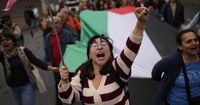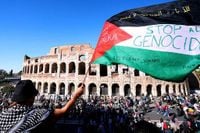Hundreds of thousands of people took to the streets across Europe on October 4 and 5, 2025, in an extraordinary wave of pro-Palestinian demonstrations, marking nearly two years since the outbreak of the Gaza war. The protests, which spanned major cities from Istanbul to Amsterdam, Barcelona to Rome, and beyond, were sparked by mounting anger over Israel’s ongoing military campaign in Gaza, the high death toll, and the recent interception of the Sumud Flotilla by Israeli forces.
In Istanbul, the largest of Turkey’s demonstrations unfolded as crowds streamed from the iconic Hagia Sophia—now a mosque—toward the banks of the Golden Horn. There, dozens of boats festooned with Turkish and Palestinian flags awaited, creating a striking tableau of solidarity. Marchers called for Muslim unity with Palestinians, their voices rising in the wake of midday prayers. According to the Associated Press, support for Palestinians remains widespread in Muslim-majority Turkey, with President Recep Tayyip Erdogan standing as a vocal critic of Israel’s actions. In the capital, Ankara, and the northern city of Kirikkale, protesters held placards decrying what they called the “genocide” in Gaza. “This oppression, which began in 1948, has been continuing for two years, turning into genocide,” said Recep Karabal of the Palestine Support Platform, addressing the gathered crowds.
Turkey’s demonstrations were mirrored by equally passionate scenes across Europe. In Amsterdam, an estimated 250,000 people—many dressed in red—filled Museum Square before marching through the city center. Their message was clear: the Dutch government must take a stronger stance against Israel. The protest’s timing was no coincidence, coming less than four weeks before national elections. The Netherlands has long been a staunch supporter of Israel, but recent months have seen a shift in rhetoric. On October 3, Dutch Foreign Minister David van Weel told reporters he was unlikely to grant export licenses for F-35 fighter jet parts destined for Israel. Protester Marieke van Zijl, quoted by AP, voiced the frustration of many: “The bloodshed must stop. And that we unfortunately have to stand here because we have such an incredibly weak government that doesn’t dare to draw a red line. That’s why we are here. In the hope that it helps.” Amnesty International’s Marjon Rozema, one of the event’s organizers, called for “all economic and diplomatic means to increase pressure on Israel.”
Elsewhere, the streets of Barcelona and Madrid were awash with Palestinian flags and banners, as tens of thousands marched on October 4. According to local authorities, around 70,000 joined the Barcelona protest, while at least 92,000 demonstrated in Madrid. Organizers, however, claimed even higher numbers, with some estimating 300,000 in Barcelona and 400,000 in Madrid. Over 600 unions, rights groups, and NGOs coordinated the events, rallying under the slogan: “An end to the arms trade and relations with Israel.” Protesters carried banners reading “Jews and Palestinians Against Genocide” and “Gaza Is Bleeding Because the Government Is Silent.” Taxi drivers in Barcelona joined the cause, waving Palestinian flags from their vehicles and honking in unison. In Valencia, 10,000 more rallied, and similar scenes played out in Sevilla, Malaga, Granada, and Valladolid. Spanish media described the demonstrations as “historic,” the largest since the war’s outbreak in October 2023.
Not all was peaceful, however. In Barcelona, police reported eight arrests and 20 officers injured, with some businesses linked to Israel—such as Carrefour, Zara, and Starbucks—vandalized. Footage broadcast by Spanish media showed clashes between police and demonstrators. Catalan politician Elisenda Alamany, reflecting on the rallies, said: “We will explain to our children that we took to the streets of Barcelona and mobilized, and that the vast majority of the people of Catalonia stood on the right side of history.” Adding to the momentum, Manchester City manager and former Barcelona football icon Pep Guardiola posted a video urging civil society to pressure governments and save lives in Gaza.
Rome, too, saw massive turnout. Organizers claimed over one million participants in the Italian capital on October 5, though police estimated the crowd at 250,000. The city’s demonstration was organized by three Palestinian groups, local unions, and student organizations. Protesters chanted and applauded the name of Francesca Albanese, the UN special rapporteur on the occupied Palestinian territories. While organizers requested only Palestinian flags, some banners praised militant groups and referenced “October 7, Day of Palestinian Resistance.” According to the Associated Press, Italy had already seen over two million people rally the previous day in a one-day general strike supporting Palestinians in Gaza.
The demonstrations were not confined to southern Europe. In Britain, hundreds gathered outside Manchester Cathedral on October 5 to mourn the victims of an attack on a synagogue just days earlier, in which two men died and the attacker was killed by police. The crowd held Israeli and UK flags, as well as signs calling for the release of hostages held by Hamas. Paris saw hundreds more march, many draped in Israeli flags, demanding the release of roughly 20 hostages believed to be alive. In Sofia, Bulgaria, demonstrators carried signs such as “Gaza: Starvation is a Weapon of War” and “Gaza is the Biggest Graveyard of Children,” paying tribute to the activists of the Global Sumud Flotilla, including Bulgarian Vasil Dimitrov. In Rabat, Morocco, marchers demanded the release of flotilla activists, including Moroccan human rights defender Aziz Ghali, still detained in Israel. An Israeli flag was burned near the front of the Rabat march as protestors called for a reversal of Morocco’s 2020 decision to normalize relations with Israel.
These protests followed the dramatic events of October 1, when Israeli forces intercepted over 40 vessels of the Gaza-bound Sumud Flotilla, arresting more than 450 activists from 40 countries—including Swedish climate campaigner Greta Thunberg. Some activists, upon deportation to Turkey, alleged mistreatment by Israeli authorities, though Israel’s foreign ministry dismissed such reports as “complete lies.” The flotilla’s interception and the detentions have become a rallying point for protesters, who demand the immediate release of all activists.
As the war in Gaza approaches its two-year mark, the toll has been staggering. According to the Gaza Health Ministry, over 67,000 Palestinians have been killed since October 2023. The humanitarian situation remains dire, with Gaza’s largest city in famine and international accusations of genocide mounting against Israel. In a development that could signal a shift, Hamas has reportedly accepted some elements of a plan proposed by former U.S. President Donald Trump to end the conflict, though full agreement has not yet been reached.
The weekend’s rallies were not a one-off event. Organizers in Spain alone said that around 80 pro-Palestinian demonstrations were expected over the two days, and smaller marches took place in Paris, Lisbon, Athens, Skopje, London, and Manchester. The message from the streets of Europe was resounding: a growing segment of the public is demanding an end to the war, accountability for civilian suffering, and a reevaluation of political and economic ties with Israel. Whether these voices will shift government policies remains to be seen, but the scale and passion of the protests have left an indelible mark on Europe’s political landscape.

